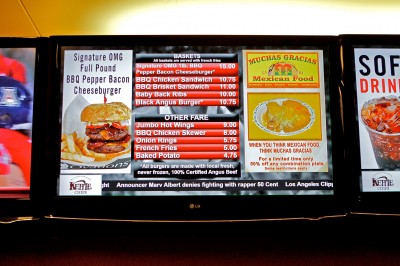Compelling content
When creating customer-facing content, important factors include compelling brand messaging and esthetic appeal. There is only a short ‘window’ with menu boards to catch customers’ attention and entice them to make a specific purchase.
Digital menu boards are well-suited to this purpose, featuring motion and bright graphics. While posters may fade or yellow, digital signage need never look old or tired. Its content can remain fresh and vibrant.
Video content, for example, is a much more appealing way to showcase signature items and specials than static imagery. Digital menu boards can cycle through video clips to ensure customers in line see as much different content as possible. As an additional bonus, digital signage has been shown to reduce their perceived waiting time.
It is common for large food-service providers to require consistent branding to be maintained across many franchised locations, while still allowing some flexibility for displaying and updating local content, such as business hours on screens visible from outside. By using digital signage software with user-permission capabilities, these chains can ensure their franchisees adhere to company-wide standards, with corporate control over key brand elements, but also can provide and change local content as relevant to their customers.

Other elements can also be added to the screen layout. In a stadium, for example, a ‘ticker’ might feature sports-related news updates.
Engaging customers
As mentioned, digital menu boards can boost sales of related merchandise, such as the jersey of a star athlete when he/she scores a goal in an arena. Another example is a QSR promoting a kids’ meal that comes with a toy tying in with a new movie or TV show.
Some companies are choosing to incorporate mobile and social media elements into their digital signage strategy. They might encourage customers to tweet with a given hashtag, for example, for the chance to win tickets to a game or other event.
These types of campaigns use digital signage to provide a more interactive and engaging experience for customers, which can lead not only to a boost in sales, but also to quick and easy access to a large pool of sample data for further marketing activities.
Indeed, one of the key differentiators between traditional and digital signage has been the ability to incorporate specialized data, both to drive content to the right people at the right time and to measure the results. In these ways, digital signage—including but not limited to menu boards—is changing how businesses manage their content and communicate with their customers.
Jeff Collard is president of Omnivex, which develops digital signage software in Concord, Ont. For more information, visit www.omnivex.com.





